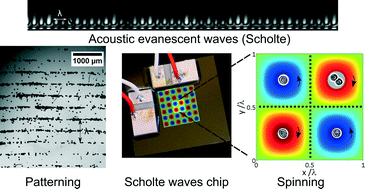A simple acoustofluidic chip for microscale manipulation using evanescent Scholte waves†
Abstract
Acoustofluidics is acknowledged as a powerful tool offering a contactless and label-free manipulation of fluids, micro-beads, and living cells. To date, most techniques rely on the use of propagating acoustic waves and take advantage of the associated acoustic radiation force in standing or progressive fields. Here, we present a new approach based on the generation of an evanescent acoustic field above a substrate. This field is obtained by means of subsonic interfacial waves giving rise to a well-defined standing wave pattern. By both imaging and probing the evanescent acoustic field, we show that these interfacial waves are guided waves known as quasi-Scholte acoustic waves. Scholte waves present very interesting features for applications in acoustofluidics. Namely, they confine the acoustic energy to the vicinity of the surface, they are nearly lossless and thus can propagate over long distances along the substrate, and finally they do not require any particular material for the substrate. With a very simple and low-cost device we show several examples of applications including patterning lines or arrays of cells, triggering spinning of living cells, and separating plasma from RBC in a whole blood microdroplet.


 Please wait while we load your content...
Please wait while we load your content...